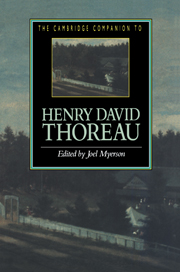Book contents
- Frontmatter
- 1 Thoreau’s reputation
- 2 Thoreau and Concord
- 3 Thoreau and Emerson
- 4 A Week on the Concord and Merrimack Rivers
- 5 Thoreau as poet
- 6 Thoreau and his audience
- 7 Walden
- 8 Thoreau in his Journal
- 9 The Maine Woods
- 10 A wild, rank place
- 11 Thoreau’s later natural history writings
- 12 Thoreau and the natural environment
- 13 Thoreau and reform
- Further reading
- Index
- Series List
11 - Thoreau’s later natural history writings
Published online by Cambridge University Press: 28 May 2006
- Frontmatter
- 1 Thoreau’s reputation
- 2 Thoreau and Concord
- 3 Thoreau and Emerson
- 4 A Week on the Concord and Merrimack Rivers
- 5 Thoreau as poet
- 6 Thoreau and his audience
- 7 Walden
- 8 Thoreau in his Journal
- 9 The Maine Woods
- 10 A wild, rank place
- 11 Thoreau’s later natural history writings
- 12 Thoreau and the natural environment
- 13 Thoreau and reform
- Further reading
- Index
- Series List
Summary
The works considered in this chapter comprise the published late natural history writings of Henry Thoreau, exclusive of material associated with The Maine Woods. This sounds simple enough, but explanation is required. Of the eight titles here discussed, six were published posthumously: “Walking, ” “Autumnal Tints, ” and “Wild Apples ” appeared in the Atlantic Monthly in 1862, shortly after Thoreau’s death; “Huckleberries ” was published in 1970; and not until 1993 were “The Dispersion of Seeds ” and a selection from his “Wild Fruits ” manuscripts published for the first time in Faith in a Seed. Thoreau himself saw in print only a truncated version of “A Yankee in Canada, ” in Putnam’s Monthly Magazine in 1853, and “The Succession of Forest Trees, ” in both the New York Tribune and Transactions of the Middlesex Agricultural Society in 1860. Because the publication dates do not reflect the order of composition, the latter order is followed here: “Walking ” (1851), “A Yankee in Canada ” (1851), “Autumnal Tints ” (1858-9), “Wild Apples ” (1859-Go), “Huckleberries ” (1860-11, “Wild Fruits ” (1860-1), “The Succession of Forest Trees ” (1860), and “The Dispersion of Seeds ” (1860-1).
While these published titles represent Thoreau’s most advanced work with their texts, the published versions of "Night and Moonlight" (1863) and The Moon (1927) have been shown to be nonauthorial editions and therefore are not discussed here. However, the surviving manuscripts of what apparently was once an intended book on the moon would be a welcome addition to the Thoreau canon, if someone can assemble and edit them. The same is true for the rest of the "Wild Fruits" manuscripts and for other late writings as well, including "The Fall of the Leaf." We should not, though, expect to read either Thoreau’s so-called Indian Book or his so-called Kalendar, because neither of these projects developed beyond the accumulation of raw materials, much of which was shifted to other works.
- Type
- Chapter
- Information
- The Cambridge Companion to Henry David Thoreau , pp. 152 - 170Publisher: Cambridge University PressPrint publication year: 1995
- 1
- Cited by

